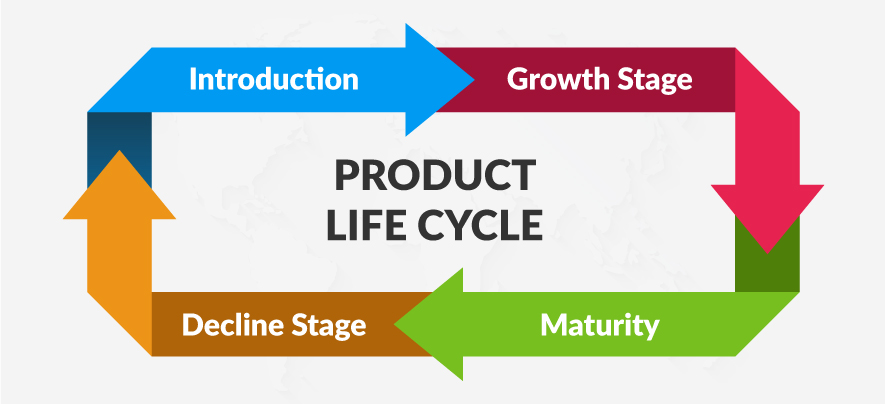
Product Life Cycle Explained + Examples
Everything has a shelf life. Whether it’s a car, phone, exercise equipment, or anything else, its use and sales potential will eventually run dry. That’s because whenever a product enters the market, it follows specific stages of the product life cycle.
The stages of a product life cycle take it from being introduced as the next big thing to something that everyone has and eventually forgets about. This process is constant, so every business needs to be aware of how it works and how it can affect their products.
Now, let’s dive into the product life cycle and how you can leverage it to manage your business.
What is a product life cycle?
The product life cycle is the time from when a product is introduced to the consumer market until it declines or is no longer sold. This cycle can be broken down into stages: development, introduction, growth, maturity, saturation, and decline. The full product life cycle is used to determine when to increase advertising, adjust pricing, explore new markets, redesign packaging, and adjust messaging.
What are the stages of a product life cycle?
Each stage has its costs, opportunities, and risks, and individual products differ in how long they remain in any life cycle stage. While there are differing opinions on the number of stages, each option includes the following steps.
1. Development
The development stage is the research phase before launch. It’s used to determine product viability, when to go to market, and how to approach the official launch. Costs accumulate at this stage, and risk is high. Funding sources are limited, with existing companies using revenue from current products and startups relying on personal resources. Landing on a minimum viable product (MVP) early on is essential.
2. Introduction
The introduction stage is when a product is first launched in the marketplace. It involves market development, analysis of the competitive landscape, and gaining initial sales. Marketing costs are high, and distribution channels and messaging need to be tested. Intellectual property rights protection is obtained, and product pricing may be high or lower, depending on market position and costs. Initial funding efforts and cash runway planning are crucial.
3. Growth
During the growth stage, the product is accepted by customers, and market share is increased. Demand and revenue grow steadily, with competitors reacting quickly in crowded markets and slower in breakout industries. Fine-tuning messaging, solidifying brand presence, and expanding into new distribution channels are essential. Additional services can be considered to support and differentiate the product.
4. Maturity and saturation
The mature stage is when sales level off, and competitors solidify their offerings. Adjustments need to be made to advance the product or its services. Incremental changes can be marketed as a refresh with new features or benefits. Lowering prices, offering free additions, or making other adjustments to stay competitive are common. Efficiency increases, production costs decline, and refined marketing strategies are implemented.
5. Decline
The decline stage occurs when the market becomes saturated, competition peaks, and customer needs change. Companies have options to discontinue the product, sell manufacturing rights, find new uses, or tap into new markets. Weighing the costs and benefits of each option is crucial. Running different forecasting scenarios helps determine product performance, and multiple products or iterations at different life cycle stages can support the business.
How do you know what stage of the product life cycle your products are in?
It can be difficult to determine the current stage of a product’s life cycle and when it transitions to the next one. Understanding the characteristics of each stage and analyzing past performance helps identify current position and future projections. Comparing financial forecasts with actual statements provides valuable insights. By painting a clearer picture of the future and avoiding poor strategic decisions, you can apply the same methodology to other products.
How to use the product life cycle to manage your business
Understanding the product life cycle stages helps develop a strategy for your product. The stage influences decisions and sales performance. You can leverage this understanding to:
– Establish authority: Differentiate your product and business during the introduction stage.
– Set a pricing strategy: Adjust pricing based on each stage’s impact.
– Create a marketing strategy: Test and refine marketing strategies at each stage.
– Extend or vary product use: Adjust the value of your product based on its stage.
What factors affect the product life cycle stages?
While you have control over how you create, position, and market your product, external factors can influence its performance and life cycle. Factors such as ease of entry into the market, advancements in technology, rate of market acceptance, and economic forces impact the product’s duration in each stage. Understanding how these factors affect your product helps you prepare and adjust accordingly.
Keep your product life cycle in mind
Understanding the product life cycle is vital for managing and growing your business. It helps you develop a detailed roadmap, make strategic decisions, and create accurate financial forecasts. Regularly assessing your product’s position in the life cycle allows you to better plan for the future and maintain a competitive edge.
Hello!
I’m Andrew Brooks, a seasoned finance consultant from the USA and the mind behind phonenumber247.com.
My career is built on a foundation of helping individuals and businesses thrive financially in an ever-changing economic landscape. At phonenumber247.com, my aim is to demystify the complex world of finance, providing clear, actionable advice that can help you navigate your financial journey with confidence. Whether it’s personal finance management, investment strategies, or understanding the nuances of market dynamics, I’m here to share insights and tools that can propel you towards your financial goals.
Welcome to my digital space, where every piece of advice is a step closer to financial clarity and success!
